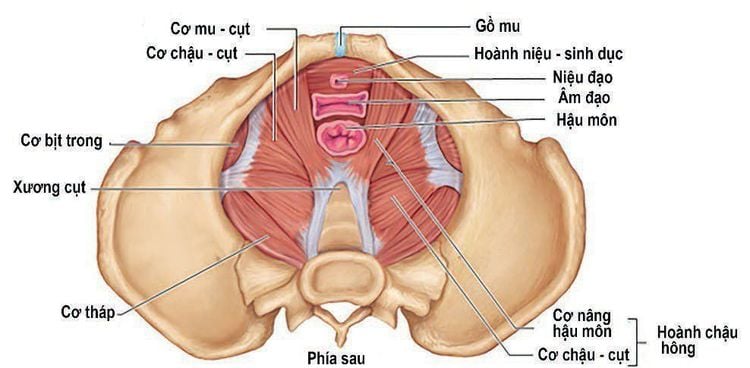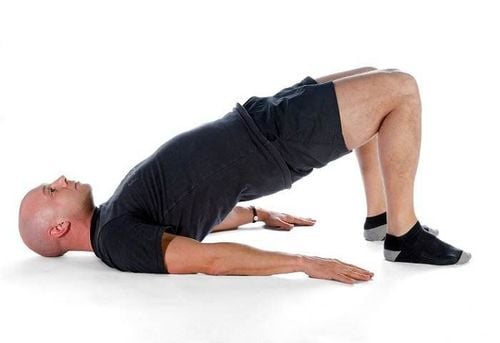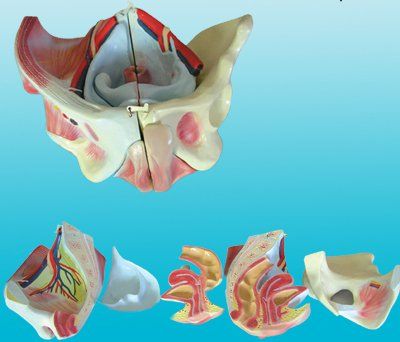This is an automatically translated article.
Article written by MSc Le Phuc Lien - Urologist, Department of General Surgery - Vinmec Nha Trang International Hospital
Pelvic floor exercises help strengthen the muscles so that they can support the pelvic organs well. This improves urinary and intestinal control and prevents fecal incontinence.
1. What is the pelvic floor muscle and where is the pelvic floor muscle located?
The pelvic floor muscles are muscles that extend from the coccyx to the pubic bone in front, forming a flat floor between the legs and supporting pelvic organs such as the bladder, uterus, and intestines. The pelvic floor muscles also control the exit of organs that pass through the muscle mass such as:Urethra: the tube that carries urine from the bladder to the outside Vagina: important for reproduction and intercourse Anal: the ejection site bowel excrement

Giải phẫu cơ sàn chậu
When the pelvic floor muscles weaken, you may experience some of the following symptoms including:
Pain and tightness in the vagina Feeling of something going down in the vagina, also known as prolapse. This is when one or more pelvic organs such as the uterus and vagina fall out of their normal position. Easy to leak urine when coughing, laughing or sneezing called stress incontinence Frequent urination during the day or night Urgent and inability to hold urine Fecal incontinence
2. Who needs to exercise the pelvic floor muscles?
All women need to exercise their pelvic floor muscles throughout their lives. Pelvic floor muscles can become weak for the following reasons:
After normal delivery Lack of exercise Menopause After pelvic surgery such as hysterectomy or bladder surgery Chronic constipation Obesity Chronic cough

Sau sinh thường phụ nữ nên tập cơ sàn chậu
3. How to exercise pelvic floor muscles?
Although pelvic floor exercises can be practiced anywhere and at any time, the best positions are still the following:
Sitting on a chair, or on the toilet Make sure your legs can to ease the blood on the floor and spread the legs wide. Bend your body forward, resting your elbows on your knees. There are 2 types of exercises: fast contractions and slow contractions. It is important to do slow contractions first and then fast contractions on each set.
How to do slow contraction exercises:
Tighten the anal muscles like wanting to hold a bowel movement. Make sure not to contract your glutes while performing the exercise. Continue tightening your vaginal and urethral muscles as you would when you want to hold your pee Hold the contraction for as long as you can and then relax. Rest for exactly the same amount of time as the muscle contraction. For example, count to 8 when contracting and then relax for a count of 8. Slowly increase the duration of the contraction and repeat until the muscle is tired.

Cách thực hiện các bài tập cơ sàn chậu
How to do quick contraction exercises:
Squeeze the pelvic floor muscles like the previous exercise. Hold for 1 second and then stretch. Repeat 5-10 times until you feel tired Pelvic floor muscles are very tired and You have to be very focused to start these exercises correctly. If you feel your muscles get tired very quickly and you can't contract them for long, then you have to contract them for as long as you can. And calculate the muscle contraction time that is your own time. For example, if you can contract a muscle for 3 hours counting, then each workout, you contract for 3 hours, then gradually increase to four and five.
Most importantly, do not do the following:
Squeeze your glutes at the same time Bend your knees at the same time Hold your breath Lift your shoulders / raise your eyebrows or lift your toes If you do these movements you are not contracting correctly .
4. How long should pelvic floor exercises be?
Try to exercise your pelvic floor muscles every day and be sure to do slow and fast contractions. Some correct contractions are better than many half-hearted contractions, but you should try to challenge yourself by increasing the number of contractions and the duration of contractions.
You can feel your pelvic floor muscles by placing one or two fingers in your vagina while showering. Try to contract your pelvic floor muscles so that you can feel them tighten in your fingers. Every 2 weeks, test the strength of your pelvic floor muscles by holding your urine midstream. This move is similar to the exercises above and uses the same muscles. You may not be able to hold your urine completely at first, but you may feel the flow of urine slow down. This is your original ability. Over time, you will see gradual improvement. It's important that you don't do this test more than once every two weeks as it can damage your bladder. This is just a way to test the effectiveness of the exercises. Always try to contract and keep your pelvic floor muscles contracted before coughing, laughing, sneezing, lifting heavy objects, or before activities that can cause urinary incontinence. Don't expect immediate results, it may take several weeks of training to achieve desired muscle strength. You need to do these exercises for the rest of your life because if you stop doing them, your problems will come back.

Tập luyện cơ sàn chậu phù hợp cho cả nam và nữ
5. What is a pelvic floor exerciser?
However, anyone who has ever practiced pelvic floor muscles will find that it is not easy to be able to practice contractions correctly. Identifying the correct pelvic floor muscles can be difficult even for healthcare professionals. With today's advances in medicine, the use of biofeedback and mild electrical stimulation has made it easier to recognize your pelvic floor muscles and exercise effectively.
Current pelvic floor exercisers use a transducer placed in the vagina to help the physiotherapist know the time and intensity of muscle contractions as well as the exact contraction. In addition, electrical stimulation also helps muscles work effectively to avoid excessive muscle contractions causing pain in diseases of constipation, overactive bladder,... These diseases occur in both men and women because It is effective in treating diseases in both men and women.
For regular pelvic floor exercises, you can practice with the pelvic floor machine about 4-6 times in the first time to be able to contract the muscles correctly, then you can practice at home and periodically check as needed. Meanwhile, for pathological cases, it is necessary to practice according to the treatment regimen in each patient.
Customers can directly go to Vinmec Health system nationwide to visit or contact the hotline here for support.
MORE:
Pelvic floor exercises, back pain relief for women after cesarean section Postpartum pelvic floor exercises Health problems can be encountered in the pelvic floor













